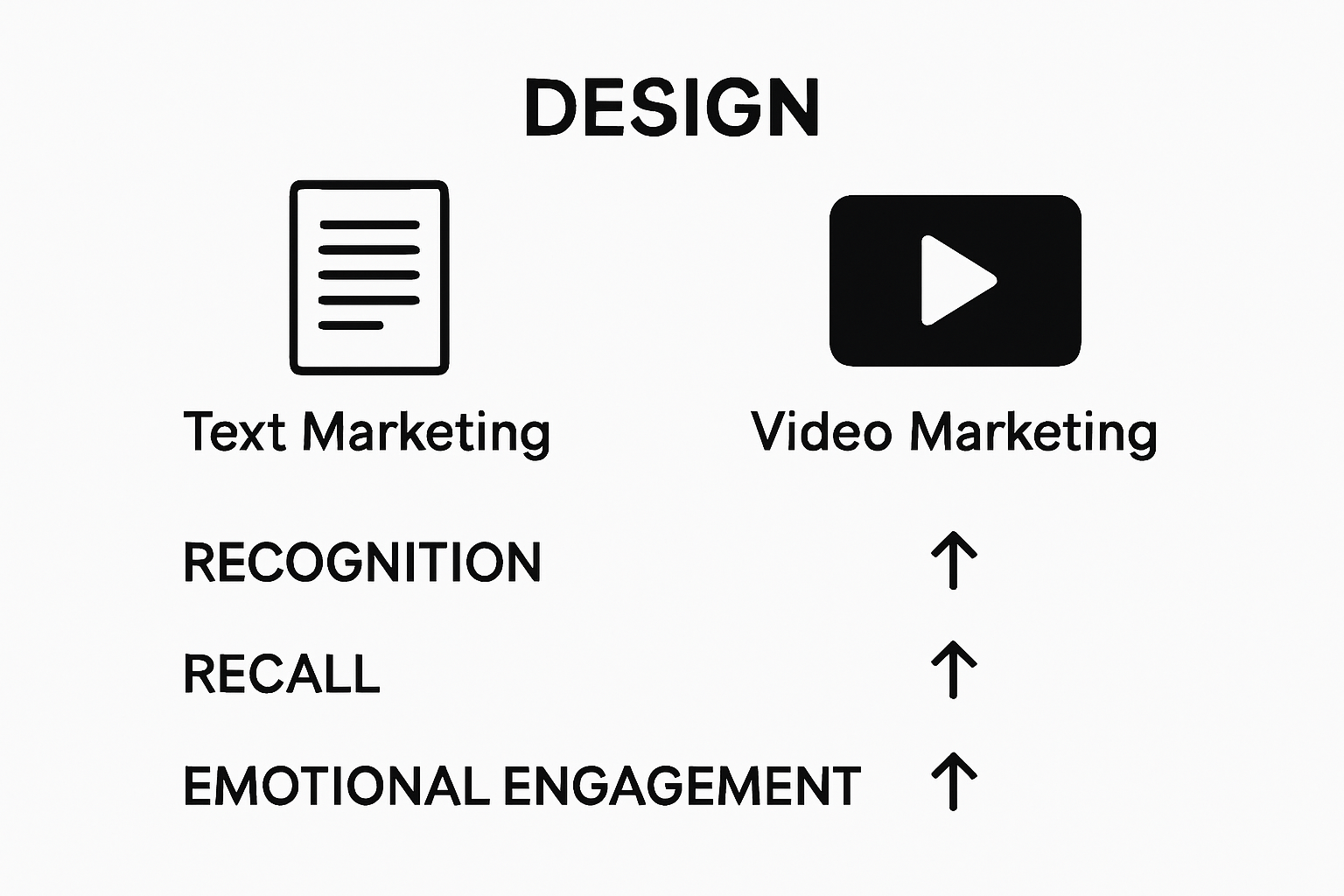Understanding the Role of Video in Brand Identity
- Pieter Nijssen
- Sep 24
- 7 min read

Brand identity shapes how a business stands out, earning trust and lasting attention. But brands with strong identities enjoy up to 23 percent higher revenue on average compared to those with weaker presence. Surprisingly, it is not only the logo or color scheme at play here. The real impact comes from the way brand identity builds emotional connections and turns every business interaction into something unforgettable.
Table of Contents
Quick Summary
Takeaway | Explanation |
Brand identity shapes customer connections. | A strong brand identity creates emotional ties with stakeholders, enhancing loyalty and trust. |
Video is essential for modern branding. | Utilizing video effectively communicates brand values and enhances emotional resonance with audiences. |
Engaging narratives boost brand recall. | Compelling storytelling in video fosters memory retention, making brand messages more memorable and impactful. |
Consistent brand messages enhance recognition. | Regular use of visual and tonal branding elements in video helps solidify brand identity in consumer minds. |
Adapt video strategies to audience needs. | Dynamic and responsive video content aligns branding with evolving viewer preferences, ensuring relevance and engagement. |
The Importance of Brand Identity in Business
Brand identity represents the strategic core of an organization’s visual and communicative representation, transcending mere logos or color schemes. It serves as a comprehensive framework that defines how a business communicates its core values, personality, and unique market positioning. Learn more about visual branding strategies to comprehend the deeper nuances of this critical business element.
Defining Brand Identity’s Core Purpose
At its fundamental level, brand identity acts as a strategic narrative that communicates an organization’s core essence. It encompasses multiple interconnected elements that collectively create a distinctive organizational persona. According to research from the South African Journal of Business Management, brand identity plays a pivotal role in establishing meaningful connections between organizations and their stakeholders.
Below is a table summarizing the key components of brand identity and their core functions, providing a clear overview of how each element contributes to the overall brand persona.
Brand Identity Component | Function in Brand Identity |
Visual design elements | Create immediate recognition and visual differentiation |
Communication tone and style | Reflect brand personality and shape customer perceptions |
Core organizational values | Convey fundamental beliefs and commitments to the audience |
Consistent messaging approach | Ensure clarity and trust through repeated messaging |
Key components of brand identity include:
Visual design elements
Communication tone and style
Core organizational values
Consistent messaging approach
Strategic Business Implications
Effective brand identity delivers significant competitive advantages. It transforms abstract organizational characteristics into tangible perceptual experiences that resonate with target audiences. Businesses with robust brand identities can differentiate themselves in crowded marketplaces, creating emotional connections that transcend traditional transactional relationships.
Brand identity influences critical business outcomes by:
Establishing immediate recognition
Building customer trust and loyalty
Communicating organizational values
Creating competitive differentiation
Successful brand identity requires meticulous strategic planning, consistent execution, and continuous refinement. It demands a holistic approach that integrates visual communication, narrative storytelling, and authentic representation of organizational culture. The most compelling brand identities emerge from genuine understanding of an organization’s unique strengths and strategic aspirations.
What Role Does Video Play in Establishing a Brand?
Video has transformed from a supplementary marketing tool to a critical mechanism for building and communicating brand identity. Learn more about video branding techniques to understand its profound impact on contemporary business communication strategies.
Visual Storytelling and Emotional Connection
Videos provide an unparalleled medium for brands to craft compelling narratives that transcend traditional text-based communication. According to research in the Journal of Education Culture and Society, visual content creates deeper emotional engagement, allowing businesses to communicate complex brand values through dynamic storytelling.
Key advantages of video in brand establishment include:
Rapid communication of brand personality
Enhanced emotional resonance with audiences
Ability to demonstrate product functionality
Increased memorability compared to static content
Strategic Brand Communication Mechanisms
Effective video content acts as a multidimensional communication tool that simultaneously informs, entertains, and persuades. By integrating visual, auditory, and narrative elements, videos enable brands to construct immersive experiences that capture audience attention more effectively than traditional marketing approaches.
Videos contribute to brand identity through:
Consistent visual and tonal branding
Showcasing organizational culture and values
Creating authentic audience connections
Differentiating from competitive messaging
The power of video in brand establishment lies in its capacity to transform abstract organizational characteristics into tangible, memorable experiences. Successful brands leverage video not merely as a promotional tool, but as a strategic communication platform that reflects their core identity, values, and unique market positioning.
How Video Enhances Brand Recognition and Recall
Video content serves as a powerful neurological catalyst for brand memory and perception, creating deeper cognitive connections than traditional marketing mediums.
Explore our comprehensive guide on corporate video branding to understand the strategic nuances of visual communication.
Cognitive Processing and Visual Memory
The human brain processes visual information exponentially faster than text, making video an extraordinarily effective communication tool.
This table highlights the comparative advantages of using video versus traditional marketing mediums in building brand recognition and recall, summarizing neurological and psychological benefits mentioned in the article.
Communication Medium | Key Advantages for Brand Recognition and Recall |
Video Content | Faster information absorption, enhanced emotional engagement, multisensory experience, greater retention of complex narratives |
Traditional Marketing Mediums | Slower information processing, less emotional engagement, limited sensory stimulation, lower retention of complex narratives |
Key neurological advantages of video include:

Faster information absorption
Enhanced emotional engagement
Multilayered sensory stimulation
Greater retention of complex narratives
Psychological Mechanisms of Brand Recall
Video leverages multiple psychological mechanisms to embed brand messages into audience consciousness. By combining auditory, visual, and narrative elements, videos create multisensory experiences that activate different memory processing centers in the brain.
Critical factors influencing brand recognition through video:
Consistent visual branding elements
Authentic storytelling techniques
Emotional resonance with target audiences
Strategic repetition of core brand messages
The intricate relationship between video content and brand memory demonstrates that modern marketing transcends mere information transmission. Successful brands understand that every visual element communicates a sophisticated narrative about organizational identity, values, and unique market positioning.
Connecting Emotionally: The Power of Storytelling Through Video
Storytelling represents the fundamental human mechanism for transmitting meaning, experiences, and emotions. Discover advanced techniques in audiovisual storytelling to understand how narratives can transform brand communication.
Narrative Architecture in Video Communication
Videos provide a sophisticated platform for constructing compelling brand narratives that transcend traditional marketing approaches. According to research published in ShodhKosh: Journal of Visual and Performing Arts, effective storytelling enables companies to communicate complex organizational values through emotionally resonant experiences.
Key elements of effective video storytelling include:
Authentic character development
Clear narrative arc
Emotional trigger points
Contextual relevance to brand mission
Emotional Engagement Mechanisms
Emotional storytelling transforms passive viewers into active participants in a brand’s narrative journey. By crafting narratives that reflect human experiences, brands can create profound connections that extend beyond transactional relationships.
Psychological dimensions of emotional video storytelling:
Activating mirror neuron responses
Generating empathetic connections
Facilitating memory encoding
Stimulating neurochemical engagement
Successful video storytelling is not about presenting information but creating immersive experiences that resonate with audience members on deeply personal levels. The most powerful brand stories are those that reflect universal human experiences while maintaining authentic organizational identity.
Practical Examples of Effective Video Branding Strategies
Video branding strategies have evolved from simplistic promotional content to sophisticated narrative experiences that communicate organizational identity. Learn about strategic approaches to promotional videos to understand how brands can leverage visual storytelling effectively.
Content Strategy and Brand Positioning
Brands are increasingly utilizing nuanced video strategies that transcend traditional marketing approaches. According to research examining online video marketing strategies, successful organizations are developing what researchers call ‘branded factual’ content — authentic stories told through strategic visual narratives.
Key components of effective video branding include:
Authentic representation of organizational values
Narrative coherence across different video formats
Strategic alignment with target audience expectations
Consistent visual and tonal branding elements
Adaptive Video Communication Techniques
Successful video branding requires a dynamic approach that responds to changing audience preferences and technological landscapes. Modern brands must create content that is simultaneously informative, engaging, and reflective of their core organizational identity.
Strategic video communication approaches:
Integrating user-generated content
Developing platform-specific content variations
Creating interactive and immersive video experiences
Implementing data-driven content personalization
The most compelling video branding strategies emerge from a deep understanding of audience psychology, technological capabilities, and organizational storytelling potential.

Brands that view video not as a marketing tool but as a sophisticated communication platform will consistently outperform traditional advertising approaches.
Make Your Brand Unforgettable Through Powerful Video Storytelling
Does your business struggle to be remembered in a crowd of similar brands? The article on brand identity reveals one key truth. It is not enough to just tell people what you offer. You need to connect with them in a way that is both emotional and memorable. Many companies miss out on real growth because their message blends into the background. You want to stand out using authentic storytelling, visual consistency, and rapid recall—exactly the advantages that high-quality video can deliver. If building trust, recognition, and a true audience connection are your goals, it is time to take your brand story beyond words.

Trust Tulip Films to turn your unique value into compelling video content that fosters instant brand recall and genuine engagement. Explore our portfolio to see how we have helped Swiss businesses create impactful video solutions that reflect their identity and connect with their audience. Start your journey with a free consultation, and let us design visuals that leave a lasting impression. Brands win with clear and authentic communication—let us help you become the brand your market remembers.
Frequently Asked Questions
What is the importance of video in establishing brand identity?
Video plays a critical role in establishing brand identity by conveying messages through visual storytelling, enhancing emotional connections, and quickly communicating brand personality.
How does video impact brand recognition and recall?
Video content significantly enhances brand recognition and recall by engaging multiple senses, allowing for faster information absorption and deeper emotional engagement compared to traditional marketing methods.
What elements should be included in a video branding strategy?
An effective video branding strategy should include authentic representation of organizational values, narrative coherence, and consistent visual and tonal branding elements tailored to resonate with the target audience.
How can brands utilize storytelling in video content?
Brands can utilize storytelling in video content by developing authentic narratives that reflect human experiences, employing clear narrative arcs, and creating emotional trigger points that engage viewers on a personal level.
Recommended